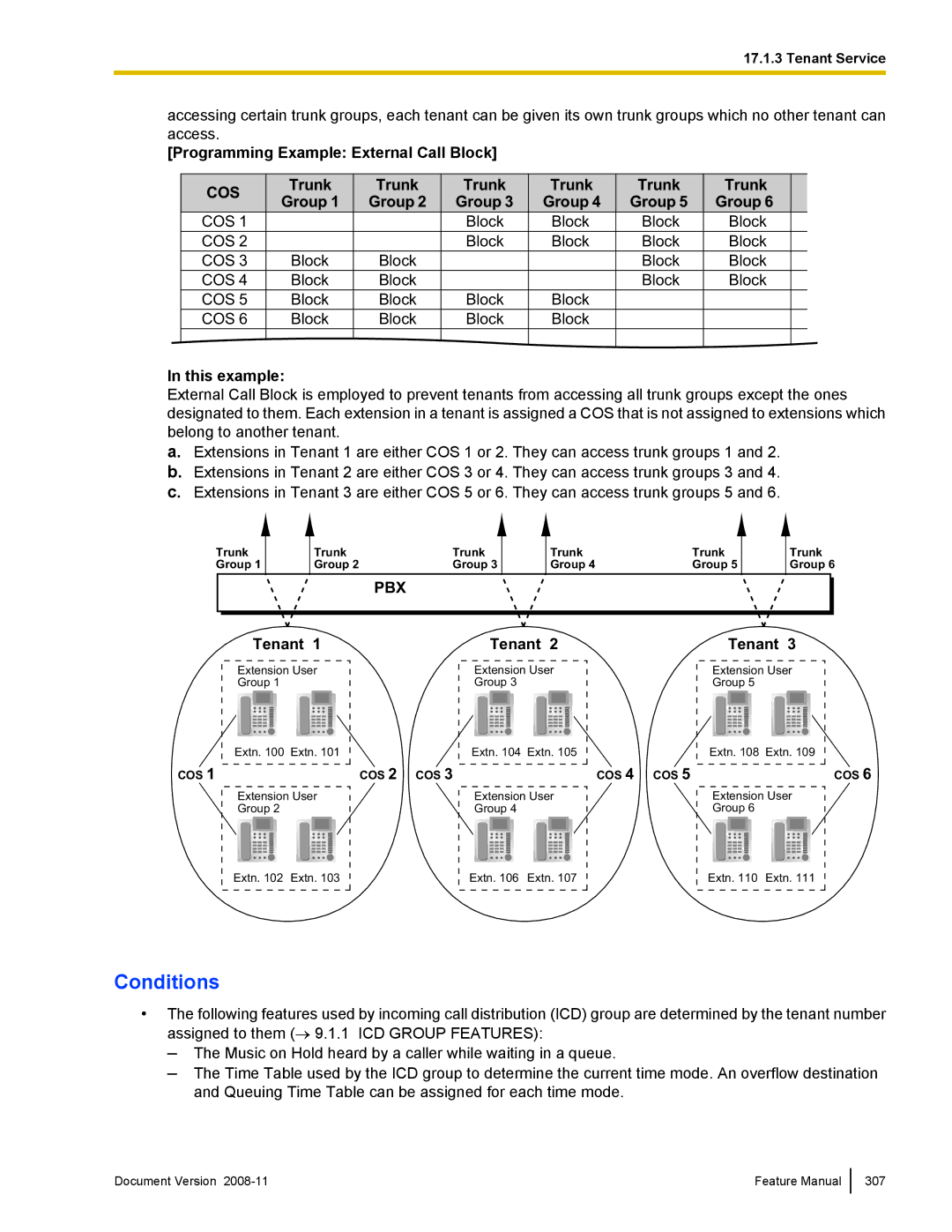
17.1.3 Tenant Service
accessing certain trunk groups, each tenant can be given its own trunk groups which no other tenant can access.
[Programming Example: External Call Block]
COS | Trunk | Trunk | Trunk | Trunk | Trunk | Trunk |
|
|
Group 1 | Group 2 | Group 3 | Group 4 | Group 5 | Group 6 |
|
| |
|
|
| ||||||
COS 1 |
|
| Block | Block | Block | Block |
|
|
COS 2 |
|
| Block | Block | Block | Block |
|
|
COS 3 | Block | Block |
|
| Block | Block |
|
|
COS 4 | Block | Block |
|
| Block | Block |
|
|
COS 5 | Block | Block | Block | Block |
|
|
|
|
COS 6 | Block | Block | Block | Block |
|
|
|
|
|
|
|
|
|
|
|
|
|
|
|
|
|
|
|
|
|
|
In this example:
External Call Block is employed to prevent tenants from accessing all trunk groups except the ones designated to them. Each extension in a tenant is assigned a COS that is not assigned to extensions which belong to another tenant.
a.Extensions in Tenant 1 are either COS 1 or 2. They can access trunk groups 1 and 2.
b.Extensions in Tenant 2 are either COS 3 or 4. They can access trunk groups 3 and 4.
c.Extensions in Tenant 3 are either COS 5 or 6. They can access trunk groups 5 and 6.
Trunk |
|
|
| Trunk | Trunk |
|
|
| Trunk | Trunk |
|
|
|
| Trunk | |||||||||||
Group 1 |
|
|
| Group 2 | Group 3 |
|
|
| Group 4 | Group 5 |
|
|
|
| Group 6 | |||||||||||
|
|
|
|
|
|
|
|
|
| PBX |
|
|
|
|
|
|
|
|
|
|
|
|
| |||
|
|
|
|
|
|
|
|
|
|
|
|
|
|
|
|
|
|
|
|
|
|
|
| |||
|
| Tenant 1 | Tenant 2 | Tenant 3 |
| |||||||||||||||||||||
|
| Extension User | Extension User | Extension User | ||||||||||||||||||||||
|
| Group 1 |
|
|
|
| Group 3 |
|
|
|
| Group 5 |
|
|
|
|
| |||||||||
|
|
|
|
|
|
|
|
|
|
|
|
|
|
| ||||||||||||
|
|
|
|
|
|
|
|
|
|
|
|
|
|
|
|
| ||||||||||
|
| Extn. 100 Extn. 101 | Extn. 104 Extn. 105 | Extn. 108 Extn. 109 | ||||||||||||||||||||||
COS 1 |
|
|
|
| COS 2 COS 3 |
|
|
| COS 4 COS 5 |
|
|
|
|
|
|
|
| COS 6 | ||||||||
|
| Extension User | Extension User | Extension User | ||||||||||||||||||||||
|
| Group 2 |
|
|
|
| Group 4 |
|
|
|
| Group 6 |
|
|
|
|
| |||||||||
|
|
|
|
|
|
|
|
|
|
|
|
|
|
|
| |||||||||||
|
|
|
|
|
|
|
|
|
|
|
|
|
|
|
|
|
|
|
| |||||||
|
| Extn. 102 | Extn. 103 | Extn. 106 | Extn. 107 | Extn. 110 | Extn. 111 | |||||||||||||||||||
Conditions
•The following features used by incoming call distribution (ICD) group are determined by the tenant number assigned to them (→ 9.1.1 ICD GROUP FEATURES):
–The Music on Hold heard by a caller while waiting in a queue.
–The Time Table used by the ICD group to determine the current time mode. An overflow destination and Queuing Time Table can be assigned for each time mode.
Document Version | Feature Manual |
307
